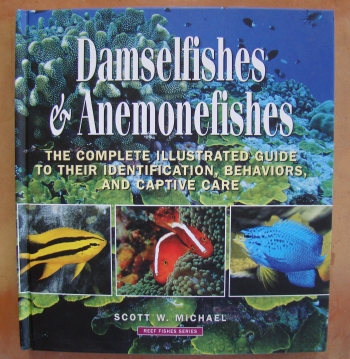
By Bob Goemans

TITLE: Reef Fishes, Volume IV: Damselfishes & Anemonefishes
AUTHOR: Scott W. Michael
PUBLISHER: T.F.H. Publications/Microcosm Ltd. (2008)
ISBN 1-890087-97-1
PAGES: 256
PRICE: $44.95 (Hardcover)

I'm glad the time between on-going books in this series has seen a somewhat drop in the time between publications, but remain somewhat disappointed that what originally began as a four book series in 1999 expanded to six books a couple of volumes later, and has now become a nine book series. With this addition being number four; it will be years, maybe a decade before the final volume becomes available! And that's if the series does not see any further lengthening. Nevertheless, this is a worthwhile addition and quite extensive, as are all previous publications in this series. Maybe the folks at Microcosm will become tired of hearing my voice when it comes to the 'next' volume and hurry that one along.
As the title of Volume IV indicates, this edition contains the species solely in the Damselfish Family (Pomacentridae), which includes both damselfishes and anemonefishes. This is probably the most widespread family of reef fishes, as it contains about 321 species divided into 28 genera, and there are probably few marine aquarists that have never kept one of its numerous species! And that's why this work is so important, as its content can help aquarists make good decisions as to what species to select, and how to properly maintain it.
The work begins with a 'Preface' that presents an up to date look at what each volume has and/or will contain. It does not include Book 9, but that one will simply be a 'Reef Fishes Encyclopedia' containing all previously published data in this enormous series. It's followed by a brief 'Acknowledgements' written by Scott and paying tribute to those who have helped him write and publish this immense work. It is followed by a 16 page section titled 'The Fishes,' which includes a full-page sketch of Generalized Bony Fish Anatomy and a map showing the Major Coral Reefs of the World. These pages enlighten the reader as to the meaning, importance or value of various general subjects/terms that will be used throughout the book, e.g., Scientific Name, Common Name, Range, Biology, Captive Care, Aquarium Size, Temperature, Aquarium Suitability Index, and Remarks.
Following that, Scott gets into the main theme of the work with a general discussion on those that makeup the Pomacentridae Family. Its 27 pages are dedicated to a broad range of topics, e.g., Classification and Biology; Food and Feeding; Damsels as Cleaners; Damselfishes and Corals; Predators; Effect of Pomacentrid Territories on Coral Reef Communities; Social Organization - Group Forming, Individual Territories, Group Territories, Clusters and Forays; Territory Defensibility; Reproduction - Mate Selection, Egg Deposition, and Sexual Dimorphism; Captive Care; and A Damsel of a Different Color, Juvenile and Adult Color Differences (which is necessary reading if one wants to purchase juveniles, as some species are quite alluring when small, but become terrors when becoming an adult!)
Individual damselfish species descriptions begin on page 61, and those in the genus Adudefduf (Sergents) begin the discussion. Of the known and described 18 species, Scott covers 13 of the better know species. The Genus Acanthocromis (Spiny Chromis) follows with one species discussed. Deepbodied Damsels, those in the Genus Amblyglyphidodon follows with four species discussed. The Genus Amblypomacentrus (Blackbanded Demoiselle) are discussed next, with one species discussed. Then those of major hobbyist interest follows with those in the Chromis , Chrysiptera , and Dascyllus genera discussed, which encompasses about 66 described species!
Before moving on to anemonefishes, the damselfish section of this work completes by describing species in the Genera Dischistodus , Lepidozygus , Microspathodon , Noglyphiddodon (some nasty adult damsels!), Neopomacentrus , Plectroglyphididodon , Pomacentrus (very popular species), Pomachromis , and Stegastes . All in all, a very complete work on the species known to hobbyists and those not too well known, and with plenty of caveats on both desirable and undesirable species.
The next 72 pages are dedicated to Anemonefishes, the Subfamily Amphiprioninae. It opens with a 40 page discussion that includes various subtopics; Systematics and Biology; Anemonefishes with More Restricted Ranges; Anemonefishes and Their Hosts; Symbiotic Anemones; Finding and Acclimating to an Anemone; Symbiotic Sea Anemones (a special insert dedicated to certain anemones and their color photos that are most frequented by anemonefishes, e.g., Adhesive Sea Anemone Stoichactis digitata; Rose/Bubbletip Sea Anemone Entacmaea quadricolor; Beaded Sea Anemone Heteractis aurora; Leathery Sea Anemone Heteractis crispa; Magnificent Sea Anemone Heteractis magnifica (ritteri); Corkscrew Sea Anemone Macrodactyla doreensis; Haddon's Carpet Anemone Stichodactyla haddoni; Merten's Carpet Anemone Stichodactyla mertensii; and, Giant Carpet Anemone Stichodactyla gigantea); Benefit to the Anemone; Other Anemone Symbionts; Anemone Care Primer; Prey, Predators, and Parasites; Anemone Life Span; Singing Anemonefish; Social Organization and Aggression; Sexual Differences and Reproduction; Captive Care; Compatibility; Disease; Reef Aquariums; Captive Spawning; Creating the Right Broodstock Environment; Captive-raised Anemonefishes; and last but not least, Egg Care and Handling. The 27 species in the Amphiprion genus and the only species in the Premnas genus are then discussed in detail next.
As mentioned earlier, almost every species described in this book has its Common Name, Maximum Length, Distribution, Biology, Captive Care, Aquarium Size and Temperature, and Aquarium Suitability discussed. Many also have a major 'Remarks' section where special items of interest are discussed. You could not ask for more!
The book completes with Bibliography, Glossary, Photography Credits, Index, and, About The Author.
And if you're wondering what's going to be in Volume V, its Wrasses and Parrotfishes. Maybe I should call Microcosm (again) and find out when Volume V is really due!
T.F.H. Publications and Microcosm Ltd. has again supplied the reader a high quality beautifully illustrated publication that is well written and informative. You don't want to be without any of these fantastic books! In my opinion, this is without doubt one of the all-time best series of books! And that's saying a lot!